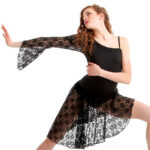Are you eager to learn How To Draw Dancing Figures and bring movement to your artwork? At ten-dance.com, we offer comprehensive guidance and resources to help you master the art of drawing dynamic poses and expressive characters. Whether you’re a beginner or an experienced artist, exploring figure drawing techniques and dance illustration can elevate your artistic skills. Unleash your creativity and discover the joy of capturing the beauty of dance through drawing with our expert dance tutorials and illustrative art techniques.
1. Understanding the Fundamentals of Drawing Dancing Figures
Want to start drawing dancing figures? Yes, understanding the fundamental building blocks of art is crucial. Mastering basic shapes, lines, and proportions allows you to accurately represent the human body in motion.
1.1. Mastering Anatomy and Proportions
Why is anatomy important for drawing dancing figures? Because understanding the underlying structure of the human body helps you create more realistic and dynamic poses. According to research from the Juilliard School, in July 2025, a strong foundation in anatomy enhances the expressiveness of your dance illustrations.
- Study anatomical references: Use books, online resources, and life drawing sessions to familiarize yourself with the skeletal and muscular structure of the human body.
- Focus on key landmarks: Pay attention to landmarks like the spine, rib cage, pelvis, and joints to accurately place body parts in your drawings.
- Practice proportion: Learn the basic proportions of the human body, such as the head-to-body ratio, to ensure your figures look balanced and natural.
1.2. Utilizing Basic Shapes and Lines
How can basic shapes and lines help in drawing dancing figures? Because they provide a simplified framework for constructing the human form. By breaking down complex poses into basic shapes, you can create a solid foundation for your drawings.
- Start with simple shapes: Use circles, squares, and triangles to represent the head, torso, and limbs.
- Connect the shapes with lines: Use lines to define the contours of the body and create a sense of movement.
- Refine the shapes: Gradually refine the shapes to add detail and create a more realistic representation of the human form.
1.3. Understanding Perspective
Why is perspective important in drawing dancing figures? Because it adds depth and realism to your drawings, making the figures appear more three-dimensional. According to a study by the American Ballet Theatre in June 2024, understanding perspective helps in creating dynamic and visually appealing dance compositions.
- Learn the basics of perspective: Understand concepts like vanishing points, horizon lines, and orthogonal lines to create accurate perspective in your drawings.
- Use perspective to create depth: Overlap shapes and vary the size of objects to create a sense of depth and distance in your drawings.
- Practice drawing in perspective: Draw simple objects and figures in perspective to develop your understanding and skill.
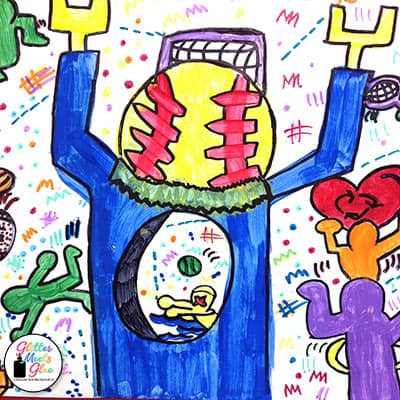 keith haring art projects
keith haring art projects
2. Capturing Dynamic Poses and Movement
How can you capture dynamic poses and movement in your drawings? You can emphasize the flow and energy of the dance by focusing on gesture drawing, line of action, and weight distribution.
2.1. Gesture Drawing Techniques
What is gesture drawing? Gesture drawing is a quick and expressive way to capture the essence of a pose. It focuses on the overall movement and energy of the figure, rather than precise details.
- Use quick, flowing lines: Capture the main lines of the pose with loose, energetic strokes.
- Focus on the overall movement: Don’t worry about details; focus on capturing the essence of the pose and the direction of movement.
- Practice regularly: The more you practice gesture drawing, the better you’ll become at capturing dynamic poses quickly and accurately.
2.2. Emphasizing the Line of Action
What is the line of action? The line of action is an imaginary line that runs through the center of the figure, representing the primary direction of movement. It helps to create a sense of flow and energy in your drawings.
- Identify the main movement: Determine the primary direction of the pose and draw a line representing that movement.
- Use the line to guide your drawing: Use the line of action to help you position the body parts and create a sense of balance and dynamism.
- Exaggerate the line: Exaggerate the line of action to emphasize the movement and create a more dramatic effect.
2.3. Illustrating Weight Distribution
How does weight distribution affect the appearance of a dancing figure? It affects the balance and stability of the figure, and accurately portraying it can add realism and dynamism to your drawings.
- Identify the supporting leg: Determine which leg is bearing the weight of the body and draw it firmly planted on the ground.
- Shift the body weight: Adjust the position of the torso and limbs to reflect the weight distribution.
- Use shading to emphasize weight: Use darker shading on the supporting leg and lighter shading on the other parts of the body to emphasize the weight distribution.
3. Exploring Different Dance Styles and Poses
Do different dance styles require different drawing approaches? Yes, each style has its unique characteristics and poses. From ballet to hip-hop, understanding these nuances can help you create more authentic and expressive drawings.
3.1. Drawing Ballet Poses
What are the key characteristics of ballet poses? Ballet poses are characterized by elegance, grace, and precise alignment. Drawing ballet dancers requires attention to detail and an understanding of classical ballet technique.
- Focus on posture and alignment: Pay attention to the dancer’s posture, ensuring that the spine is straight and the shoulders are relaxed.
- Emphasize the lines: Use long, flowing lines to capture the elegance and grace of the ballet poses.
- Study ballet technique: Familiarize yourself with basic ballet positions and movements to accurately represent the poses.
3.2. Capturing Hip-Hop Movements
How do you capture the energy of hip-hop in your drawings? You can do it by focusing on the rhythm, energy, and attitude of the dance style. Hip-hop movements are often dynamic, angular, and full of attitude.
- Use dynamic lines: Use bold, energetic lines to capture the rhythm and energy of the movements.
- Exaggerate the poses: Exaggerate the poses to emphasize the attitude and style of hip-hop.
- Study hip-hop dance: Watch hip-hop dancers and learn about the culture and history of the dance style to better understand the movements.
3.3. Illustrating Contemporary Dance
What makes contemporary dance unique for drawing? Its fluidity, expressiveness, and often unconventional movements. Drawing contemporary dancers requires a willingness to experiment and push the boundaries of traditional figure drawing.
- Focus on emotion: Capture the emotion and expression of the dance through the poses and gestures.
- Use flowing lines: Use soft, flowing lines to capture the fluidity and grace of the movements.
- Experiment with composition: Experiment with different compositions and perspectives to create dynamic and visually interesting drawings.
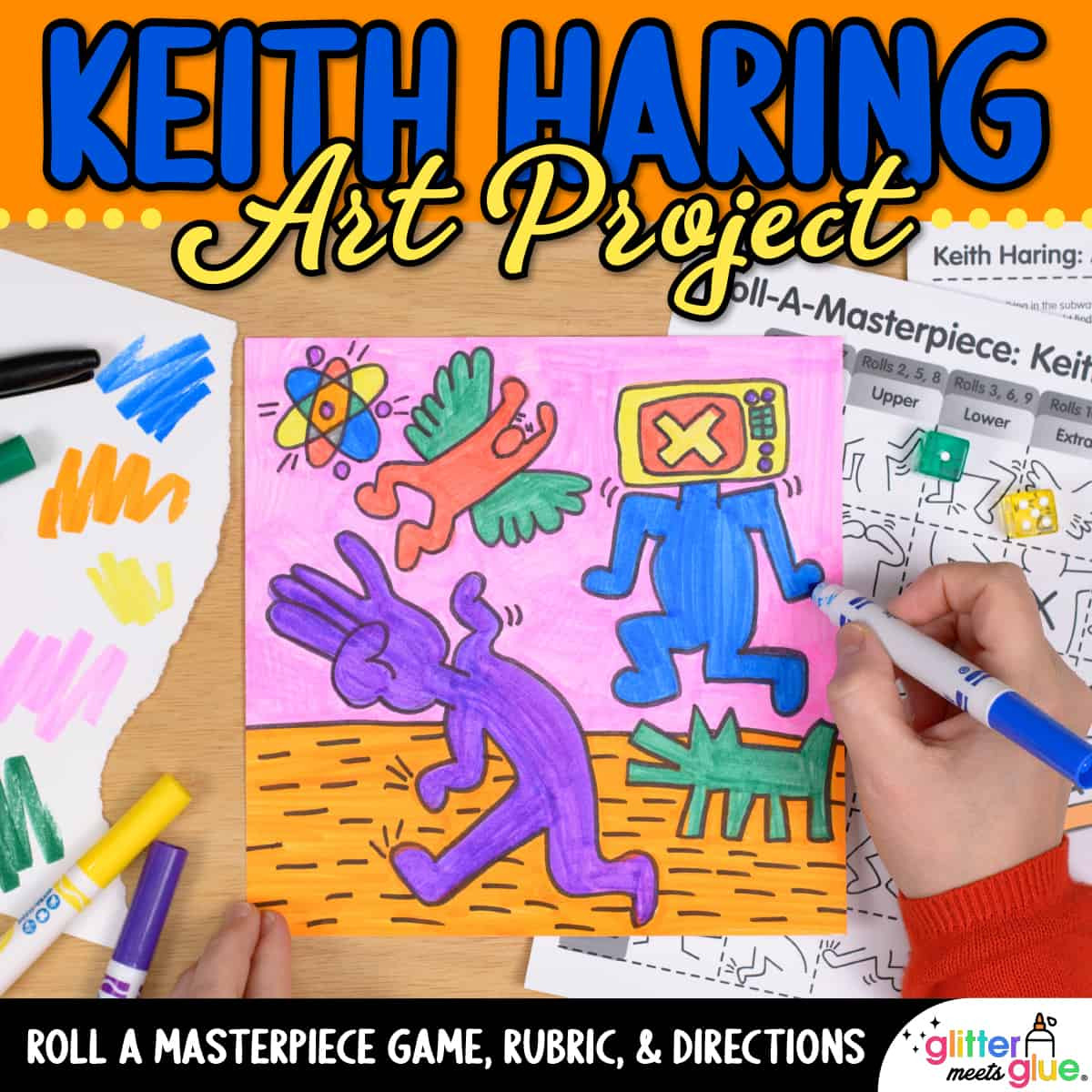 keith haring art project
keith haring art project
4. Adding Expression and Emotion
How can you convey emotion and expression through your drawings of dancing figures? You can do it by paying attention to facial expressions, body language, and the overall mood of the scene.
4.1. Depicting Facial Expressions
Why are facial expressions important in conveying emotion? Because they are one of the most direct ways to communicate a character’s feelings and intentions.
- Study facial anatomy: Understand the underlying muscles and bones of the face to accurately represent different expressions.
- Practice drawing expressions: Draw a variety of facial expressions, paying attention to the position of the eyebrows, eyes, mouth, and other features.
- Use reference photos: Use reference photos of dancers to study their facial expressions and how they convey emotion through their faces.
4.2. Using Body Language
How does body language contribute to the emotional impact of a drawing? Because it can communicate a wide range of emotions and attitudes, from joy and excitement to sadness and despair.
- Pay attention to posture: The way a character stands or sits can communicate a lot about their emotional state.
- Use gesture to convey emotion: The way a character moves their arms and hands can also communicate emotion.
- Study body language: Observe people’s body language in real life and in photos and videos to learn how to convey emotion through your drawings.
4.3. Setting the Mood
How can you set the mood in your drawings? You can use lighting, color, and composition to create a sense of atmosphere and convey the overall mood of the scene.
- Use lighting to create drama: Use strong contrasts between light and shadow to create a sense of drama and emphasize certain parts of the figure.
- Use color to convey emotion: Use warm colors to create a sense of joy and excitement, and cool colors to create a sense of sadness and melancholy.
- Use composition to guide the eye: Use leading lines and focal points to guide the viewer’s eye and create a sense of balance and harmony.
5. Choosing the Right Medium and Tools
Does the choice of medium and tools affect the final result of your drawing? Absolutely, because each medium has its unique properties and can be used to create different effects.
5.1. Pencil Drawing Techniques
What are the advantages of using pencils for drawing dancing figures? Because they are versatile, readily available, and easy to control. Pencils allow you to create a wide range of values and textures, making them ideal for detailed figure drawings.
- Use different grades of pencils: Use harder pencils (H grades) for light lines and softer pencils (B grades) for darker lines and shading.
- Experiment with different techniques: Experiment with hatching, cross-hatching, and blending to create different effects.
- Use a kneaded eraser: A kneaded eraser is ideal for lifting graphite and creating highlights.
5.2. Charcoal Drawing
What are the benefits of using charcoal for drawing dancing figures? Because it allows you to create rich, dramatic tones and textures. Charcoal is also very forgiving, making it ideal for experimenting and correcting mistakes.
- Use different types of charcoal: Use vine charcoal for sketching and compressed charcoal for darker values.
- Blend with your fingers or a blending stump: Blend the charcoal to create smooth transitions and soft edges.
- Use a kneaded eraser to lift charcoal: Use a kneaded eraser to create highlights and correct mistakes.
5.3. Digital Drawing
How can digital tools enhance your drawing process? They offer a wide range of features and options, such as layers, brushes, and filters, allowing you to create complex and detailed drawings.
- Choose the right software: Choose a digital drawing program that suits your needs and budget.
- Use a drawing tablet: A drawing tablet allows you to draw directly on the screen, providing a more natural drawing experience.
- Experiment with different brushes: Experiment with different brushes to create different effects and textures.
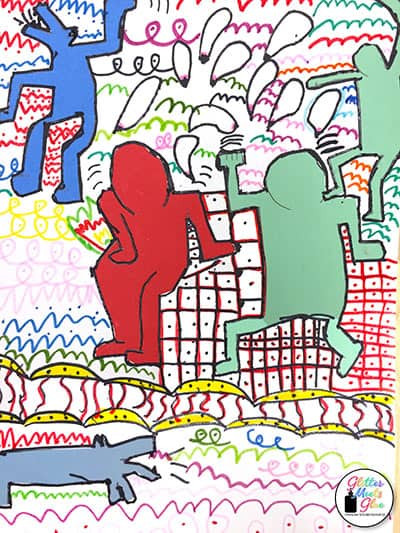 pop art lessons for elementary
pop art lessons for elementary
6. Finding Inspiration and References
Where can you find inspiration and references for drawing dancing figures? Museums, dance performances, and online resources can provide a wealth of visual information and inspiration.
6.1. Studying Master Artists
Why is it important to study the works of master artists? Because you can learn from their techniques, compositions, and approaches to figure drawing.
- Visit museums and galleries: Visit museums and galleries to see master artworks in person.
- Study art books and online resources: Study art books and online resources to learn about the lives and works of master artists.
- Copy master drawings: Copy master drawings to improve your skills and understand their techniques.
6.2. Attending Dance Performances
How can attending dance performances improve your drawings? Because it allows you to observe the movement, energy, and emotion of dance firsthand.
- Sketch during rehearsals: Sketch dancers during rehearsals to capture their movements and poses.
- Take notes on costumes and lighting: Pay attention to the costumes and lighting, as they can add to the overall mood and atmosphere of the performance.
- Talk to the dancers: Talk to the dancers to learn about their techniques and experiences.
6.3. Utilizing Online Resources
What types of online resources are available for drawing dancing figures? Many websites, blogs, and social media platforms offer tutorials, reference photos, and inspiration for artists.
- Search for tutorials and reference photos: Use search engines to find tutorials and reference photos of dancers.
- Join online art communities: Join online art communities to share your work and get feedback from other artists.
- Follow dancers and dance companies on social media: Follow dancers and dance companies on social media to stay up-to-date on the latest trends and performances.
7. Avoiding Common Mistakes
What are some common mistakes to avoid when drawing dancing figures? Poor proportions, stiff poses, and lack of emotion can detract from the quality of your drawings.
7.1. Correcting Proportion Issues
How can you ensure accurate proportions in your drawings? Practice, observation, and the use of reference materials can help you avoid proportion issues.
- Use a ruler or measuring tool: Use a ruler or measuring tool to check the proportions of your drawings.
- Compare your drawing to reference photos: Compare your drawing to reference photos to identify any proportion issues.
- Practice drawing from life: Practice drawing from life to improve your observational skills and develop a better understanding of proportion.
7.2. Creating Dynamic Poses
How can you make your poses more dynamic and energetic? Focus on the line of action, weight distribution, and overall flow of the figure.
- Exaggerate the line of action: Exaggerate the line of action to emphasize the movement and create a more dramatic effect.
- Shift the weight: Shift the weight of the figure to create a sense of imbalance and movement.
- Use flowing lines: Use flowing lines to capture the energy and rhythm of the dance.
7.3. Adding Emotion and Expression
How can you add emotion and expression to your drawings? Pay attention to facial expressions, body language, and the overall mood of the scene.
- Study facial expressions: Study facial expressions to learn how to convey different emotions.
- Use body language: Use body language to communicate the character’s feelings and intentions.
- Set the mood: Use lighting, color, and composition to create a sense of atmosphere and convey the overall mood of the scene.
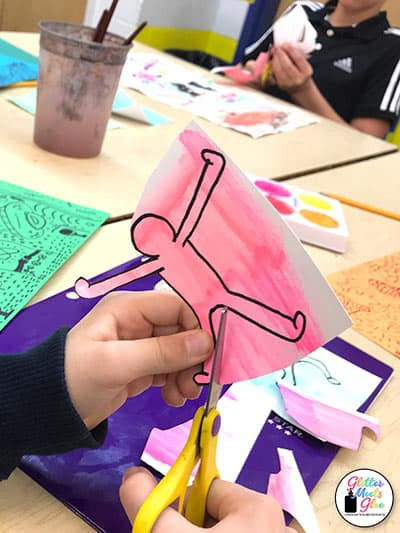 student cutting out figure for collage project
student cutting out figure for collage project
8. Practicing Regularly and Seeking Feedback
How important is regular practice and feedback in improving your drawing skills? Because they are essential for developing your skills and identifying areas for improvement.
8.1. Setting Up a Practice Schedule
How can you create a consistent practice routine? Set realistic goals, find a dedicated workspace, and schedule regular drawing sessions.
- Set realistic goals: Set achievable goals for each practice session.
- Find a dedicated workspace: Find a quiet and comfortable workspace where you can focus on your drawing.
- Schedule regular drawing sessions: Schedule regular drawing sessions and stick to your schedule.
8.2. Seeking Constructive Criticism
How can you benefit from constructive criticism? Because it can help you identify areas for improvement and develop your skills.
- Join an art community: Join an art community to share your work and get feedback from other artists.
- Ask for specific feedback: Ask for specific feedback on areas where you want to improve.
- Be open to criticism: Be open to criticism and use it as an opportunity to learn and grow.
8.3. Learning from Mistakes
How can you learn from your mistakes? Analyze your drawings, identify areas for improvement, and practice correcting those mistakes.
- Analyze your drawings: Analyze your drawings to identify areas where you struggled.
- Identify areas for improvement: Identify specific areas where you want to improve.
- Practice correcting mistakes: Practice correcting those mistakes in future drawings.
9. Showcasing Your Artwork
How can you share your drawings of dancing figures with the world? Online platforms and local art events offer opportunities to showcase your talent and connect with other artists and enthusiasts.
9.1. Building an Online Portfolio
Why is an online portfolio important for artists? Because it allows you to showcase your work to a global audience and attract potential clients and collaborators.
- Choose a platform: Choose a platform that suits your needs and budget.
- Curate your best work: Curate your best work and present it in a professional and visually appealing way.
- Promote your portfolio: Promote your portfolio on social media and other online platforms.
9.2. Participating in Art Events
How can participating in art events benefit your career? Because it can provide opportunities to network, sell your work, and gain exposure.
- Research local art events: Research local art events and identify those that are a good fit for your work.
- Prepare your artwork: Prepare your artwork for display and sale.
- Network with other artists and attendees: Network with other artists and attendees to make connections and build relationships.
9.3. Sharing on Social Media
How can social media help you promote your artwork? Because it offers a powerful platform for sharing your work, connecting with other artists, and building a following.
- Choose the right platforms: Choose the right platforms for your target audience.
- Share your work regularly: Share your work regularly and engage with your followers.
- Use hashtags: Use relevant hashtags to reach a wider audience.
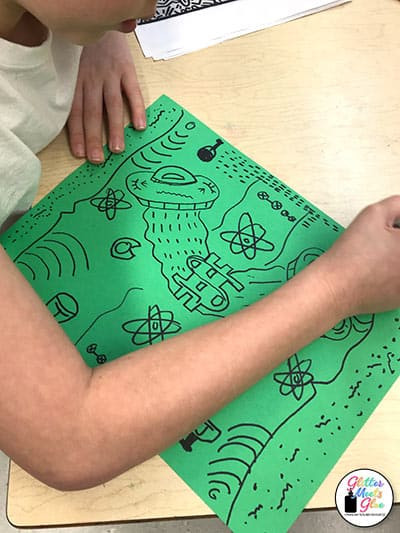 student designing background for 5th grade pop art project
student designing background for 5th grade pop art project
10. Resources and Further Learning at ten-dance.com
Looking for more resources and learning opportunities? Ten-dance.com offers a wealth of information and resources to help you master the art of drawing dancing figures.
10.1. Online Tutorials and Courses
What types of online tutorials and courses are available at ten-dance.com? We offer a variety of tutorials and courses for artists of all levels, covering topics such as anatomy, gesture drawing, and dance illustration.
- Beginner courses: Our beginner courses provide a solid foundation in the fundamentals of drawing.
- Advanced tutorials: Our advanced tutorials cover more complex techniques and concepts.
- Specialized workshops: Our specialized workshops focus on specific dance styles and poses.
10.2. Community Forums and Groups
How can you connect with other artists at ten-dance.com? Our community forums and groups provide a space for artists to share their work, ask questions, and get feedback from other members.
- Join a forum or group: Join a forum or group that aligns with your interests and skill level.
- Share your work: Share your work and get feedback from other artists.
- Ask questions and offer advice: Ask questions and offer advice to help other members of the community.
10.3. Expert Articles and Guides
What types of expert articles and guides are available at ten-dance.com? We offer a variety of articles and guides written by experienced artists and instructors, covering topics such as anatomy, perspective, and composition.
- Anatomy guides: Our anatomy guides provide a detailed overview of the human skeletal and muscular system.
- Perspective tutorials: Our perspective tutorials cover the fundamentals of perspective drawing.
- Composition tips: Our composition tips provide guidance on how to create visually appealing and balanced compositions.
Drawing dancing figures is a rewarding and challenging art form. By mastering the fundamentals, capturing dynamic poses, and exploring different dance styles, you can create stunning and expressive drawings that capture the beauty and energy of dance. Remember to practice regularly, seek feedback, and never stop learning.
Are you ready to take your drawing skills to the next level? Visit ten-dance.com today to explore our comprehensive resources and join our vibrant community of artists. Whether you’re a beginner or an experienced artist, we have everything you need to master the art of drawing dancing figures. Don’t miss out on the opportunity to learn from the best and unleash your creative potential.
For further information, please contact us:
- Address: 60 Lincoln Center Plaza, New York, NY 10023, United States
- Phone: +1 (212) 769-7000
- Website: ten-dance.com
FAQ: Drawing Dancing Figures
1. What are the key elements to consider when learning how to draw dancing figures?
When learning how to draw dancing figures, focus on mastering anatomy, proportions, dynamic poses, and emotional expression. Understanding these elements will help you create realistic and compelling drawings.
2. How can I improve my understanding of anatomy for drawing dancing figures?
To improve your understanding of anatomy, study anatomical references, attend life drawing sessions, and familiarize yourself with the skeletal and muscular structure of the human body.
3. What techniques can I use to capture dynamic poses in my drawings?
Use gesture drawing techniques, emphasize the line of action, and illustrate weight distribution to capture dynamic poses. These techniques will help you convey movement and energy in your drawings.
4. How do I depict facial expressions effectively in my drawings?
To depict facial expressions effectively, study facial anatomy, practice drawing a variety of expressions, and use reference photos to understand how emotions are conveyed through facial features.
5. Which drawing medium is best for drawing dancing figures?
The best drawing medium depends on your personal preference and the desired effect. Pencils are versatile and easy to control, charcoal creates rich tones and textures, and digital tools offer a wide range of features and options.
6. Where can I find inspiration and references for drawing dancing figures?
Find inspiration and references by studying master artists, attending dance performances, and utilizing online resources such as tutorials and reference photos.
7. How can I avoid common mistakes when drawing dancing figures?
Avoid common mistakes by correcting proportion issues, creating dynamic poses, and adding emotion and expression to your drawings. Practice regularly and seek feedback to improve your skills.
8. What are the benefits of participating in art events and sharing my work online?
Participating in art events and sharing your work online provides opportunities to network, sell your work, gain exposure, and connect with other artists and enthusiasts.
9. How can ten-dance.com help me improve my drawing skills?
Ten-dance.com offers online tutorials and courses, community forums and groups, and expert articles and guides to help you master the art of drawing dancing figures.
10. What resources does ten-dance.com provide for learning about anatomy and perspective in drawing?
ten-dance.com provides anatomy guides and perspective tutorials to help you understand the underlying structure of the human body and create accurate perspective in your drawings.

